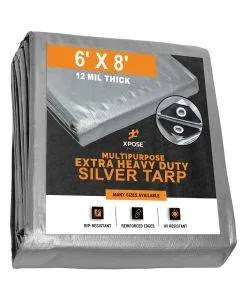Unveiling the Versatility: Poly Tarps as the All-Purpose Solution for Protection
In the realm of protective coverings, poly tarps emerge as the unsung heroes, offering a versatile and reliable solution for a myriad of applications. Whether it's safeguarding outdoor assets from the elements, creating temporary shelters, or providing robust construction site covers, poly tarps have become synonymous with durability and adaptability. This article explores the multifaceted nature of poly tarps, delving into their composition, applications, and the reasons behind their ubiquity in various industries.
The Composition of Poly Tarps
Poly tarps, short for heavy duty tarps, are crafted from a synthetic polymer known for its strength, flexibility, and resistance to the elements. Polyethylene, a thermoplastic material, is the foundation of these tarps, and their composition can include a variety of additives to enhance specific characteristics.
One of the key advantages of poly tarps lies in their lightweight nature while maintaining robustness. The combination of polyethylene and reinforcing materials results in a durable yet easy-to-handle covering that can withstand a range of environmental conditions.
Applications Across Industries
Poly tarps have found a home in numerous industries due to their adaptability and resilience. Their applications span from the agricultural sector to construction sites, outdoor events, and emergency response scenarios.
Agriculture and Farming: In agriculture, Heavy Duty Industrial Tarps serve as indispensable tools for protecting crops, equipment, and livestock from adverse weather conditions. These tarps act as shields against sunlight, rain, and wind, contributing to increased crop yields and overall farm efficiency.
Construction Sites: On construction sites, where exposure to the elements can be a constant challenge, poly tarps provide an efficient and cost-effective solution. They are used as construction site covers, protecting materials, equipment, and work areas from rain, dust, and debris.
Outdoor Events: The versatility of poly tarps shines in the realm of outdoor events. From music festivals and fairs to camping trips, these tarps are employed as makeshift shelters, ground coverings, and even as banners for promotional purposes.
Transportation: Poly tarps play a crucial role in the transportation industry, where securing and protecting cargo during transit is paramount. Waterproof and durable, these tarps ensure that goods are shielded from rain, snow, and other environmental factors.
Emergency Response: In emergency situations, such as natural disasters or humanitarian crises, poly tarps are deployed as temporary shelters, providing quick and effective protection for displaced individuals.
Key Features and Advantages
The widespread use of poly tarps can be attributed to several key features and advantages:
Water Resistance: Poly tarps are inherently water-resistant, making them ideal for protecting assets and materials from rain and moisture. This quality is especially crucial in construction, agriculture, and transportation.
UV Resistance: Many poly tarps are treated with UV inhibitors, enhancing their resistance to sunlight. This makes them suitable for prolonged outdoor use without succumbing to degradation caused by prolonged sun exposure.
Tear Resistance: The strength of polyethylene, combined with reinforcing materials, results in tarps that are highly resistant to tearing. This durability ensures a longer lifespan and reliable protection in challenging conditions.
Flexibility and Ease of Use: Poly tarps are known for their flexibility and ease of handling. Their lightweight nature facilitates quick deployment and installation, making them practical for a wide range of applications.
Affordability: Compared to some alternative materials, poly tarps are cost-effective. Their affordability, coupled with their durability, makes them a popular choice for both short-term and long-term applications.

Comments
Post a Comment